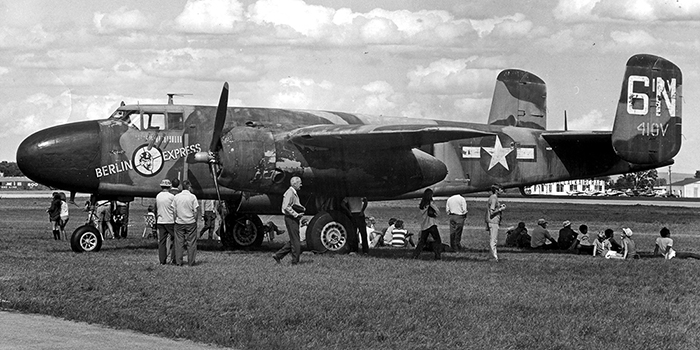The Powerhouse of the Pacific
The B-25 was named in honor of Wisconsinite Maj. Gen. William “Billy” Mitchell, a U.S. military aviation pioneer. Commonly known as Billy’s Bomber, it was a twin-tail, mid-wing land monoplane powered by two 1,700-horsepower Wright Cyclone engines. Nearly 10,000 were produced from 1939 to 1945 and the aircraft became standard equipment for Allied forces during the war. The aircraft was considered one of the most deadly, carrying up to 3,000 pounds of bombs.
But for many, the B-25 is best known for its role during the raid on Tokyo on April 18, 1942, that was led by Col. Jimmy Doolittle. On that day, four months after the devastating attack on Pearl Harbor, Hawaii, 16 B-25s took off from the pitching flight deck of the USS Hornet. This attack exemplified America’s resolve to strike the Japanese homeland. The success of the raid lies in the tremendous boost in American morale and in also forcing the Japanese to devote vital resources to protecting their territory.
The Project
As part of our mission to share The Spirit of Aviation and curate aviation’s role in the United States and beyond, EAA is proud to announce a campaign to restore and return our North American Aviation (NAA) B-25H bomber back to flying condition. When complete, it will join EAA’s B-17 and Ford Tri-Motor flight experience aircraft and travel the country, bringing aviation history to life. In particular, the B-25 will continue to tell the story of World War II and of the greatest generation’s commitment to service, country, and honor.
Project Budget and the Need for Charitable Support
Passionate volunteers working side-by-side and guided by EAA’s talented mechanics have allowed our organization to begin the restoration process. But in order for this worthwhile project to succeed, EAA needs significant charitable support going forward to bring this aircraft back to flying condition by the spring of 2018. To meet this objective, EAA needs to secure $400,000 in charitable funds to ensure that the following stages of the B-25 restoration are completed:
- Overhaul existing engines, propellers and acquire a back-up engine
- Repair hydraulic systems
- Install new brakes and wheels
- Install new avionics and engine instruments
- Interior and exterior painting
- Install new seating and passenger safety equipment
Restoring the B-25 is all about sharing the aircraft’s history, teaching the importance of it, and helping people understand the contributions made by the crews who flew these planes and those who built them.
Contribute to the B-25 Restoration

